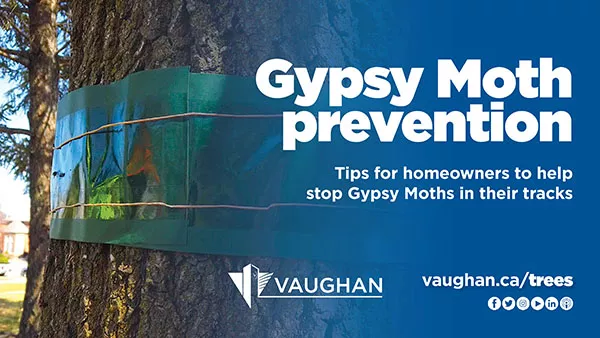Gypsy Moth prevention
Tips for homeowners to help stop Gypsy Moths in their tracks
This summer, residents may notice a certain type of caterpillar or moth on trees throughout Vaughan. These could be Gypsy Moths – destructive pests that were spotted throughout the community last year and have been found on approximately 500 species of trees.
Gypsy Moths are invasive insects that were first seen in Ontario in 1969. As caterpillars, they are dark-coloured, hairy and have a double row of blue and red spots down their backs; as moths, they are light-brown and white. These insects prefer to eat hardwood tree leaves from oaks, maples, basswoods, birches and aspens, as well as select shrubs. However, during an infestation, they may de-leaf any hardwood species.
This summer, residents may notice a certain type of caterpillar or moth on trees throughout Vaughan. These could be Gypsy Moths – destructive pests that were spotted throughout the community last year and have been found on approximately 500 species of trees.
Gypsy Moths are invasive insects that were first seen in Ontario in 1969. As caterpillars, they are dark-coloured, hairy and have a double row of blue and red spots down their backs; as moths, they are light-brown and white. These insects prefer to eat hardwood tree leaves from oaks, maples, basswoods, birches and aspens, as well as select shrubs. However, during an infestation, they may de-leaf any hardwood species.
The Gypsy Moth has five stages of life:
- Egg masses
- Early-stage caterpillar
- Late-stage caterpillar
- Pupa (in a cocoon)
- Adult moth
The female adult will lay its eggs on the trunk of a tree and will eventually emerge as caterpillars. Once hatched, the caterpillars will eat the leaves but will otherwise not harm the trees and will feed for approximately seven weeks. The trees will usually be able to grow a second crop of leaves in the same season; however, the damage to leaves can make trees more susceptible to other pests, drought and poor growing conditions.
To help control the Gypsy Moth population, the City of Vaughan will begin city-wide treatment in May for 500 residential trees followed by an additional 500 trees in heavily infested areas.
What can residents do?
Prevention and early control are important. At this time of year, Gypsy Moths will be in the first two stages of their life cycle. To control egg masses and early-stage caterpillars, homeowners can:
- pick caterpillars off leaves, tree trunks and branches and soak them in soapy water to destroy them.
- apply biological pesticides (PDF) to the trees.
- scrape off and destroy egg masses.
The removal and destruction of egg masses drastically reduces the presence of caterpillars the following season.
Additional resources can be found on the Ministry of Agriculture, Food and Rural Affair’s webpage. If you have concerns about trees on your property, contact an arborist. For materials and supplies, contact your local nursery or garden supply store.
To receive the City’s latest updates as they happen, sign up for the City Update eNewsletter at vaughan.ca/CityUpdate and follow the City’s Twitter, Facebook and Instagram channels.
-30-

